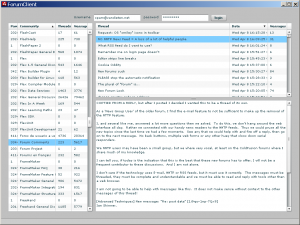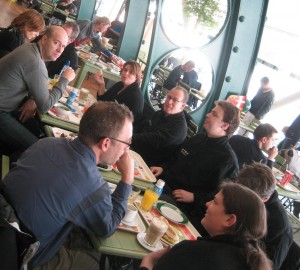Two weeks ago Adobe informed us we could preview and test the new version of the online community forums. At first glance these forums offer an exciting new look with many new features. A single login system where we can use our Adobe ID to log on to the forums, RSS support, an improved search and room for attachments are great new features.
But when I started digging at what features the forums offered the excitement pretty soon turned into a feeling of unease. The old forums were an open system, accessible through NNTP, which provided two way interaction that allowed people to run their own interface and program against the forums through the NNTP ‘API’. Yet the new forums appeared to be a closed system following the old ‘ thou shalt watch me the way I want’ ways. So the questions that pretty soon bubbled up were not of excitement. Is this all? How am I going to work around this layout? How am I going to work with this workflow? And then the feeling of unease turned into a feeling of disappointment.
The new forums are state of the art. The web interface is so much better then the previous one. And yet they are a disappointment. Because they may be state of the art, but they do nothing new. Nothing we haven’t seen before. Nothing to inspire us. Adobe is merely catching up, not leading the way. And in the process Adobe is throwing away the one open interface I had to program against the forums.
You see, I am an avid NNTP user. When I start my client, it automatically goes out on the web to collect all new messages I follow. That is currently 27 newsgroups (on the Adobe, Macromedia, prerelease and other servers) with on average 40 message per day each. And when these messages are collected, they are sorted, filtered, grouped and prioritized for me. Messages get filtered out if I don’t like the sender or subject, people that post a direct response to me get priority, threads I have hidden before won’t resurface, etc. All of that takes maybe 20 seconds, and then a thousand messages have been reduced to two dozen priority messages from people who are waiting for me and have responded to me, a bunch of messages I may find interesting, and the rest that I don’t find interesting is gone. Now how is that going to work with these new forums? What is the closed system of these new forums offering that allow me to automate my workflow to the same level as NNTP offers? And I know that many other NNTP users struggle with the same questions.
Now I have done some research into possible solutions. And surprisingly enough the answer is really, really simple. It took me two hours to build a system that converted the email feed from the new forums to NNTP. All it takes is a subscription on all forums and a small script to convert email headers to NNTP headers. That means you have to replace the header “To: Joh Doe <JohnDoe@example.invalid>” with the header “Newsgroups: general.english_discussions”. And then I write that converted email to the spool folder of the Apache James NNTP server and I have an operational email to NNTP conversion. Sure, it doesn’t have avatars, author profiles, ‘mark as answer’ functionality, but as a NNTP user I really couldn’t care less about that. And the beauty of it is that this is two-way access because all I need to do is click “Reply to user” instead of “Reply to newsgroup” and the email will go to the Reply by email functionality for the forums.
Now to get the last bit of functionality implemented, I just need Adobe to fix their last bug. Email has all these hidden header fields that tell email clients how different messages relate to each other. And Adobe is filling them out incorrectly, so I can not sort messages correctly. So if Adobe could please fix the References and / or In-Reply-To headers in the outgoing email that would make me really happy. And if I am really happy, I might just open up my NNTP server for others.
And it gets better. Because the new forums could easily become inspiring. Because as it turns out, the new Adobe forums have a webservice API. And that API is enabled. And we can program against that API using Flex or more likely AIR (because of the local storage and to bypass any cross domain problems) and build their own interfaces for the forums and customize them. Write plugins for them, for instance to easily link to documentation or copy examples. Or people could write their own automation rules again, so they can sort, filter and prioritize messages the same way they can now through the NNTP ‘API’. I have a bunch of ideas for things I could do (which I probably won’t if Adobe fixes the email bugs), and I am sure there are many more people with even better ideas.
But for that to happen Adobe first needs to do something. The forums may have a webservice API right now, but it doesn’t have any documentation. Sure, there is some documentation from the vendor of the forum, but the implementation of the Adobe ID based login system of the new forums is different. And without a login no API access.
I really think Adobe has an opportunity to make these forums great. The number or forums that truly integrates web, email and NNTP is very limited. Adobe could be the first one to not only do that, but also allow unlimited AIR extensions through its webservices and empower the community to build its own tools. Or is Adobe, the company that is preaching the gospel of the Rich Internet Applications, really forcing all users to go back to a web interface?



